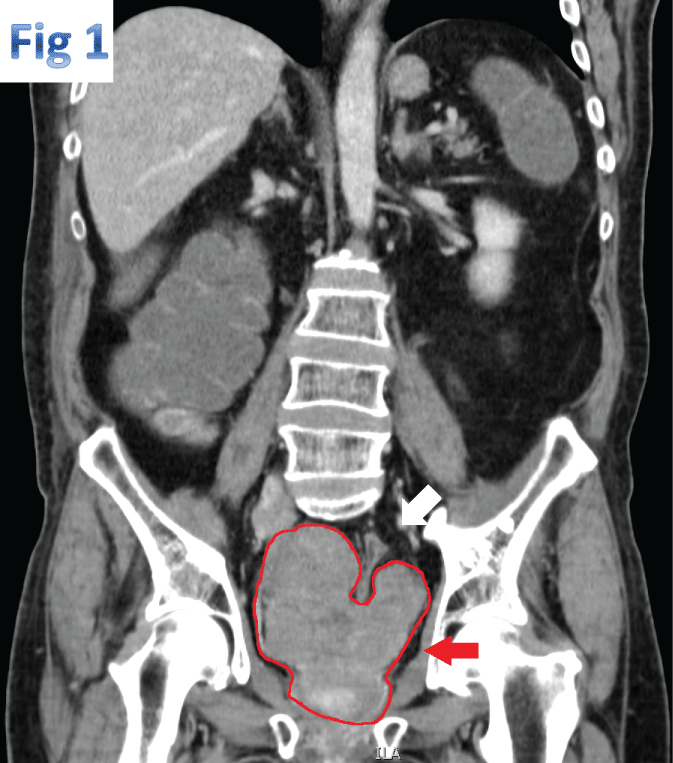International Archives of Urology and Complications
Ileus as First Sign of De Novo Neuroendocrine Prostate Cancer
Mads Ryø Jochumsen1, Bjørn Agerbo Sahlholdt2 and Jørgen Bjerggaard Jensen1
1Department of Urology, Regionshospitalet Holstebro, Denmark
2Department of Radiology, Regionshospitalet Herning, Denmark
*Corresponding author: Mads Ryø Jochumsen, Department of Urology, Regionshospitalet Holstebro, Denmark, E-mail: madsjoch@rm.dk
Int Arch Urol Complic, IAUC-3-021, (Volume 3, Issue 1), Research Article; ISSN: 2469-5742
Received: October 19, 2016 | Accepted: February 09, 2017 | Published: February 13, 2017
Citation: Jochumsen MR, Sahlholdt BA, Jensen JB (2017) Ileus as First Sign of De Novo Neuroendocrine Prostate Cancer. Int Arch Urol Complic 3:021. 10.23937/2469-5742/1510021
Copyright: © 2017 Jochumsen MR, et al. This is an open-access article distributed under the terms of the Creative Commons Attribution License, which permits unrestricted use, distribution, and reproduction in any medium, provided the original author and source are credited.
Abstract
A 73-year-old man with almost no previous medical history was admitted acute with stomach pain, distended abdomen, stop of defecation and feculent vomiting. The patient had been constipated for three months and about a month before admission, a coloscopy was performed presenting no findings. Computed Tomography (CT) showed mechanical bowel obstruction and a huge malignantly transformed prostate gland as the triggering cause. The form of the prostate gland was almost like a horseshoe squeezing the rectum, making passage impossible. Additional findings were retroperitoneal and iliac lymph node conglomerates. A colostomy was performed, and later on the patient was referred to the Department of Urology and prostate biopsies and surgical castration were performed. The patient had tumor masses impassable for the index finger. Total findings were massive lymph node metastasis and only a single small bone metastasis in the L2 corpora. Histology showed neuroendocrine prostate cancer (NEPC), which is a cancer with high malignancy characterized by lymph node metastasis instead of bone metastasis. The patient died three weeks after being diagnosed. De novo NEPC is rare and has an extremely poor prognosis. NEPC is more often seen as a result of treatment with hormone therapy. This case presents a rare debut symptom of a rare form of de novo cancer, illustrating the importance of a proper digital rectal examination when diagnosing constipation and acute abdomen.
Keywords
NEPC, Neuroendocrine prostate cancer, Prostate cancer
Case Report
A 73-year-old man with almost no previous medical history was admitted acute with stomach pain, distended abdomen, stop of defecation, feculent vomiting, metallic sounding intestines and 1 liter of urine retention. The patient had been constipated for three months, and about a month before admission a coloscopy was performed presenting no findings. Laxative treatment had no effect. An acute CT displayed mechanical bowel obstruction triggered by a malignantly transformed prostate gland. The form of the prostate gland was almost like a horseshoe (Figure 1, red arrow) squeezing the rectum (Figure 1, white arrow), making passage impossible. Additional findings were retroperitoneal and iliac lymph node conglomerates and a deep venous thrombosis (DVT) in the right external iliac vein. There was no suspicion of bone metastasis. At this stage prostate specific antigen (PSA) was analyzed and showed an increased value of 225 ng/ml. A gastric tube was inserted, and the large bowel was desufflated twice, but the patient finally had a colostomy because of total bowel obstruction. The DVT was treated with low-molecular heparin. The patient stabilized on this treatment, with normalization of bowel function and reduced stomach pain. Considerable pain in the perinea region remained, especially when seated and when moving. At this stage the patient was referred to the Department of Urology where transrectal ultrasound and digital rectal examination were performed revealing a huge T4 prostate cancer with almost no identifiable structures, and a rectal lumen impassable for the index finger. The patient was immediately medically castrated with GnRH-antagonist, and later simultaneous surgical castration and prostate biopsies were performed in general anesthesia due to severe pain. Magnetic Resonance (MR) and bone scintigraphy revealed a single small bone metastasis in the corpus of L2. Histology diagnosed NEPC, and the patients died within three weeks after diagnosis.

.
Figure 1: Coronal plane of a CT-scan showing the malignantly transformed prostate gland (line and inferior arrow) squeezing the rectum (superior arrow).
View Figure 1
Discussion
De novo NEPC is rare, occurring in only 0.5% to 2% of prostatic primary tumors. NEPC is more often seen as a result of hormone therapy, illustrated by development of this phenotype in up to 10% to 20% of cases with hormone-refractory disease [1]. NEPC is a highly aggressive prostate cancer, which frequently lack androgen receptor expression, and consequently responds poorly to hormonal therapies. NEPC has an extremely poor prognosis. NEPC often presents with bulky tumor masses, lymph node- and visceral metastasis and sometimes predominance of lytic bone metastasis [2,3]. Due to the lack of androgen receptors PSA levels are often disproportionally low in NEPC, as expression of PSA mainly is induced by androgens and regulated by the androgen receptor at transcriptional level [4].
Because of the aggressiveness of the disease and the lack of response to hormonal treatment, NEPC indicates multidisciplinary treatment with either early chemotherapy, primary surgery or surgery, for example cystectomy, in case of incomplete response to chemotherapy [5]. In this particular case only palliative treatment was considered, due to the patients general condition. Because of the aggressiveness of the disease it is very important to diagnose NEPC as early as possible, both de novo, but also treatment related NEPC. The latter probably being the hardest one to recognize, but clinical evidence of progression without a proportional increase in PSA, bulky tumor masses and visceral metastasis should alert the clinician [6]. Furthermore new ways of measuring treatment response is needed in NEPC due to the lack of correlation between PSA and volume of disease.
Conflicts of Interest
None.
References
-
Yashi M, Terauchi F, Nukui A, Ochi M, Yuzawa M, et al. (2006) Small-cell neuroendocrine carcinoma as a variant form of prostate cancer recurrence: a case report and short literature review. Urol Oncol 24: 313-317.
-
Aggarwal R, Zhang T, Small EJ, Armstrong AJ (2014) Neuroendocrine prostate cancer: subtypes, biology, and clinical outcomes. J Natl Compr Canc Netw 12: 719-726.
-
Stein ME, Bernstein Z, Abacioglu U, Sengoz M, Miller RC, et al. (2008) Small cell (neuroendocrine) carcinoma of the prostate: etiology, diagnosis, prognosis, and therapeutic implications--a retrospective study of 30 patients from the rare cancer network. Am J Med Sci 336: 478-488.
-
Kim J, Coetzee GA (2004) Prostate specific antigen gene regulation by androgen receptor. J Cell Biochem 93: 233-241.
-
Izquierdo L, Peri L, Leon P, Ramírez-Backhaus M, Manning T, et al. (2015) The role of cystectomy in elderly patients - a multicentre analysis. BJU Int 116: 73-79.
-
Aparicio A, Tzelepi V (2014) Neuroendocrine (small-cell) carcinomas: why they teach us essential lessons about prostate cancer. Oncology (Williston Park) 28: 831-838.





